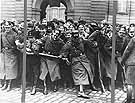
|
|
|

|

|

|

|
|
Click on an image to see a larger, more detailed picture.
|
|
|
|
|
| 1933: The Nazi State Begins |

|
pg. 61 |

|
|
|
|
| |
 A Berlin police officer (left) and a member of the SA patrol the streets after the burning of the Reichstag building. Granted police authority by Hitler's government, members of the SA and SS used their powers to suppress political opponents. The government approved of the intimidation tactics of Nazi shock troops, who effectively hounded Communists and Socialists--as well as Jews--into submission.
A Berlin police officer (left) and a member of the SA patrol the streets after the burning of the Reichstag building. Granted police authority by Hitler's government, members of the SA and SS used their powers to suppress political opponents. The government approved of the intimidation tactics of Nazi shock troops, who effectively hounded Communists and Socialists--as well as Jews--into submission.
Photo: Bundesarchiv/United States Holocaust Memorial Museum Photo Archive
|
 With the full powers of government at their disposal following passage of the Enabling Act, the SA unleashed a terror campaign against opponents of the Nazi regime. Unauthorized beatings and periods of police detention were common occurrences. The brown-shirted Storm Troopers were feared throughout Germany, and the Nazi swastika became a symbol of the repressive, omnipotent state.
With the full powers of government at their disposal following passage of the Enabling Act, the SA unleashed a terror campaign against opponents of the Nazi regime. Unauthorized beatings and periods of police detention were common occurrences. The brown-shirted Storm Troopers were feared throughout Germany, and the Nazi swastika became a symbol of the repressive, omnipotent state.
Photo: Bildarchiv Preussischer Kulturbesitz/United States Holocaust Memorial Museum Photo Archive
|
 Police struggle to hold back enthusiastic crowds waiting to greet the chancellor and president at the opening of the Reichstag in Potsdam on March 21, 1933. Marching together into the Garrison Church, the young chancellor, Adolf Hitler, and the aged president, Field Marshal Paul von Hindenburg, symbolized the joining of Germany's glorious past with its vibrant future.
Police struggle to hold back enthusiastic crowds waiting to greet the chancellor and president at the opening of the Reichstag in Potsdam on March 21, 1933. Marching together into the Garrison Church, the young chancellor, Adolf Hitler, and the aged president, Field Marshal Paul von Hindenburg, symbolized the joining of Germany's glorious past with its vibrant future.
Photo: AP/Wide World Photos
|
|

|

|

|

|
 March 21, 1933: Special Nazi courts are set up to deal with political dissidents.
March 21, 1933: Special Nazi courts are set up to deal with political dissidents.
|
 March 21, 1933: This is the Day of Potsdam--the first opening of a Nazi-controlled Reichstag.
March 21, 1933: This is the Day of Potsdam--the first opening of a Nazi-controlled Reichstag.
|
 March 22, 1933: The first concentration camp, Dachau, is established in south Germany. By 1945 the Nazis will build more than 1000 camps.
March 22, 1933: The first concentration camp, Dachau, is established in south Germany. By 1945 the Nazis will build more than 1000 camps.
|
 March 23, 1933: Ermächtigungsgesetz (Enabling Act), passed by the Reichstag, gives Hitler's government dictatorial powers. Hitler promises that Germany's artistic growth will be fueled by "blood and race."
March 23, 1933: Ermächtigungsgesetz (Enabling Act), passed by the Reichstag, gives Hitler's government dictatorial powers. Hitler promises that Germany's artistic growth will be fueled by "blood and race."
|
 March 27, 1933: A gigantic anti-Nazi protest rally, organized by the American Jewish Congress, is held in New York City. 55,000 people attend and threaten to boycott German goods if the Germans carry out their planned permanent boycott of Jewish-owned stores and businesses.
March 27, 1933: A gigantic anti-Nazi protest rally, organized by the American Jewish Congress, is held in New York City. 55,000 people attend and threaten to boycott German goods if the Germans carry out their planned permanent boycott of Jewish-owned stores and businesses.
|
 April 1, 1933: The German government institutes the first official boycott of Jewish lawyers, doctors, and merchants. Due to international outrage and the apathy of many non-Jewish Germans, Hitler orders the boycott limited to a single day.
April 1, 1933: The German government institutes the first official boycott of Jewish lawyers, doctors, and merchants. Due to international outrage and the apathy of many non-Jewish Germans, Hitler orders the boycott limited to a single day.
|
|
|
|
|
| 1933: The Nazi State Begins |

|
pg. 61 |

|
|
The Holocaust Chronicle
© 2009 Publications International, Ltd.
|
|
